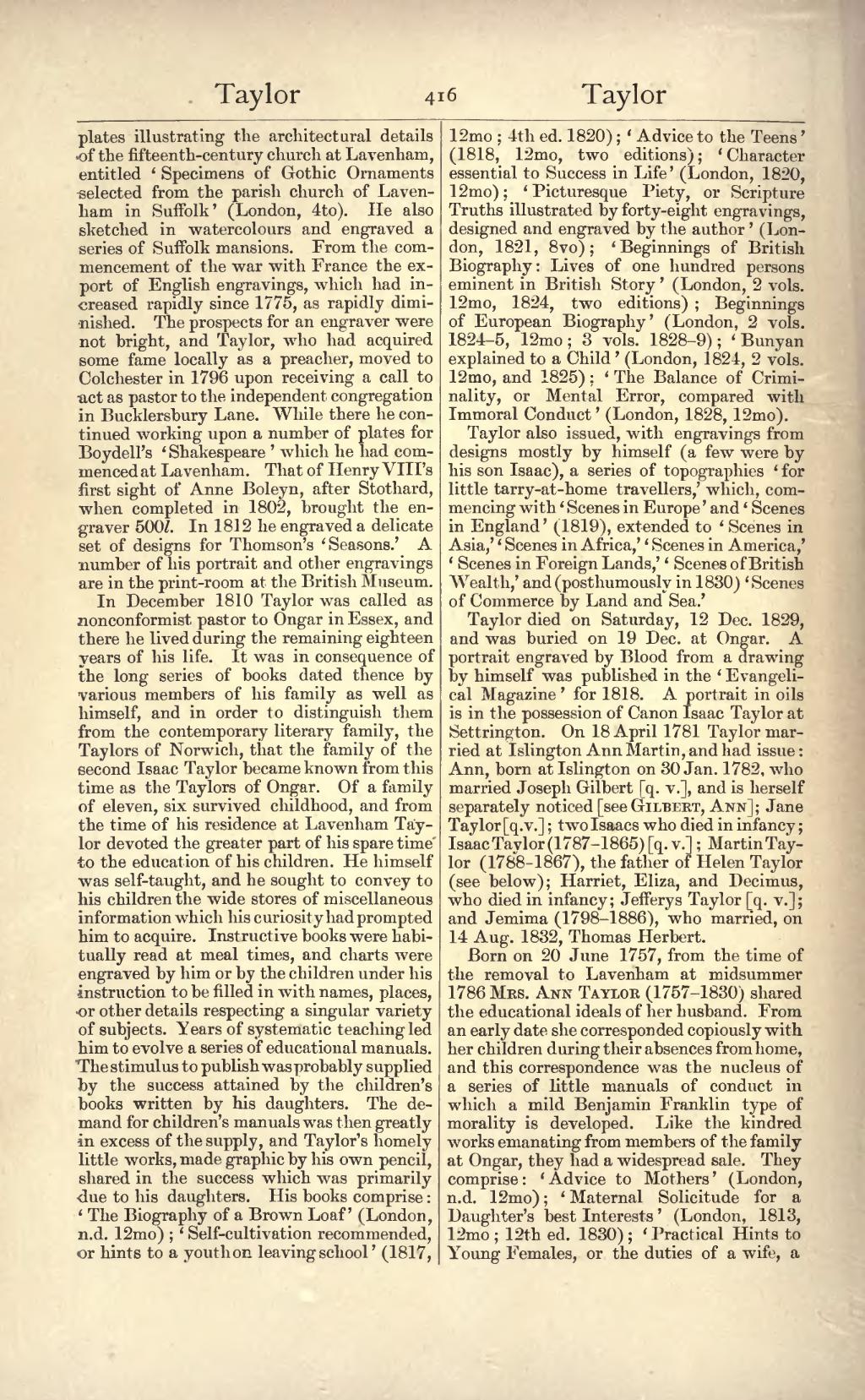plates illustrating the architectural details of the fifteenth-century church at Lavenham, entitled ‘Specimens of Gothic Ornaments selected from the parish church of Lavenham in Suffolk’ (London, 4to). He also sketched in watercolours and engraved a series of Suffolk mansions. From the commencement of the war with France the export of English engravings, which had increased rapidly since 1775, as rapidly diminished. The prospects for an engraver were not bright, and Taylor, who had acquired some fame locally as a preacher, moved to Colchester in 1796 upon receiving a call to act as pastor to the independent congregation in Bucklersbury Lane. While there he continued working upon a number of plates for Boydell’s ‘Shakespeare’ which he had commenced at Lavenham. That of Henry VIII’s first sight of Anne Boleyn, after Stothard, when completed in 1802, brought the engraver 500l. In 1812 he engraved a delicate set of designs for Thomson’s ‘Seasons.’ A number of his portrait and other engravings are in the print-room at the British Museum.
In December 1810 Taylor was called as nonconformist pastor to Ongar in Essex, and there he lived during the remaining eighteen years of his life. It was in consequence of the long series of books dated thence by various members of his family as well as himself, and in order to distinguish them from the contemporary literary family, the Taylors of Norwich, that the family of the second Isaac Taylor became known from this time as the Taylors of Ongar. Of a family of eleven, six survived childhood, and from the time of his residence at Lavenham Taylor devoted the greater part of his spare time to the education of his children. He himself was self-taught, and he sought to convey to his children the wide stores of miscellaneous information which his curiosity had prompted him to acquire. Instructive books were habitually read at meal times, and charts were engraved by him or by the children under his instruction to be filled in with names, places, or other details respecting a singular variety of subjects. Years of systematic teaching led him to evolve a series of educational manuals. The stimulus to publish was probably supplied by the success attained by the children’s books written by his daughters. The demand for children’s manuals was then greatly in excess of the supply, and Taylor’s homely little works, made graphic by his own pencil, shared in the success which was primarily due to his daughters. His books comprise: ‘The Biography of a Brown Loaf’ (London, n.d. 12mo); ‘Self-cultivation recommended, or hints to a youth on leaving school’ (1817, 12mo; 4th ed. 1820); ‘Advice to the Teens’ (1818, 12mo, two editions); ‘Character essential to Success in Life’ (London, 1820, 12mo); ‘Picturesque Piety, or Scripture Truths illustrated by forty-eight engravings, designed and engraved by the author’ (London, 1821, 8vo); ‘Beginnings of British Biography: Lives of one hundred persons eminent in British Story’ (London, 2 vols. 12mo, 1824, two editions); Beginnings of European Biography’ (London, 2 vols. 1824–5, 12mo; 3 vols. 1828–9); ‘Bunyan explained to a Child’ (London, 1824, 2 vols. 12mo, and 1825); ‘The Balance of Criminality, or Mental Error, compared with Immoral Conduct’ (London, 1828, 12mo).
Taylor also issued, with engravings from designs mostly by himself (a few were by his son Isaac), a series of topographies ‘for little tarry-at-home travellers,’ which, commencing with ‘Scenes in Europe’ and ‘Scenes in England’ (1819), extended to ‘Scenes in Asia,’ ‘Scenes in Africa,’ ‘Scenes in America,’ ‘Scenes in Foreign Lands,’ ‘Scenes of British Wealth,’ and (posthumously in 1830) ‘Scenes of Commerce by Land and Sea.’
Taylor died on Saturday, 12 Dec. 1829, and was buried on 19 Dec. at Ongar. A portrait engraved by Blood from a drawing by himself was published in the ‘Evangelical Magazine’ for 1818. A portrait in oils is in the possession of Canon Isaac Taylor at Settrington. On 18 April 1781 Taylor married at Islington Ann Martin, and had issue: Ann, born at Islington on 30 Jan. 1782, who married Joseph Gilbert [q. v.], and is herself separately noticed [see Gilbert, Ann]; Jane Taylor [q.v.] ; two Isaacs who died in infancy; Isaac Taylor (1787–1865) [q.v.] ; Martin Taylor (1788–1867), the father of Helen Taylor (see below); Harriet, Eliza, and Decimus, who died in infancy; Jefferys Taylor [q. v.]; and Jemima (1798–1886), who married, on 14 Aug. 1832, Thomas Herbert.
Born on 20 June 1757, from the time of the removal to Lavenham at midsummer 1786 Mrs. Ann Taylor (1757–1830) shared the educational ideals of her husband. From an early date she corresponded copiously with her children during their absences from home, and this correspondence was the nucleus of a series of little manuals of conduct in which a mild Benjamin Franklin type of morality is developed. Like the kindred works emanating from members of the family at Ongar, they had a widespread sale. They comprise: ‘Advice to Mothers’ (London, n.d. 12mo); ‘Maternal Solicitude for a Daughter’s best Interests’ (London, 1813, 12mo; 12th ed. 1830); ‘Practical Hints to Young Females, or the duties of a wife, a
